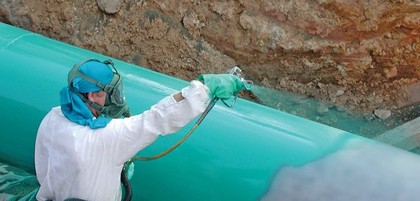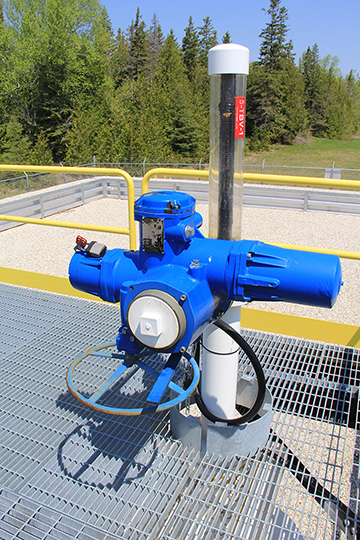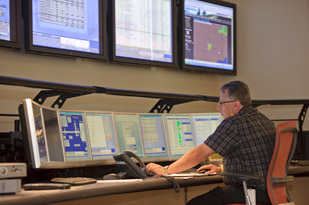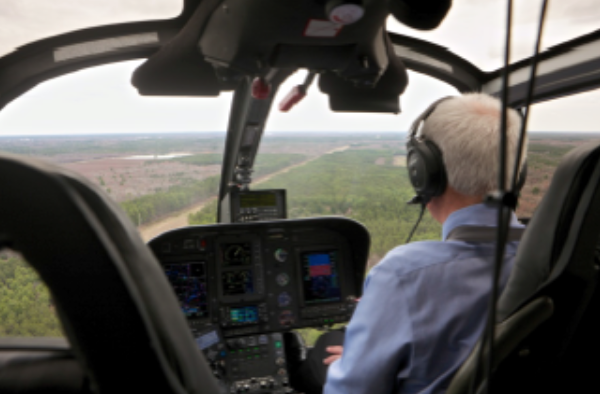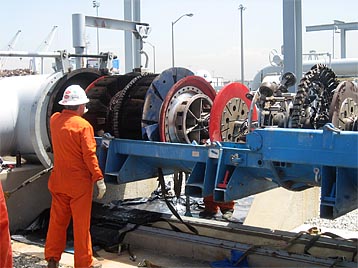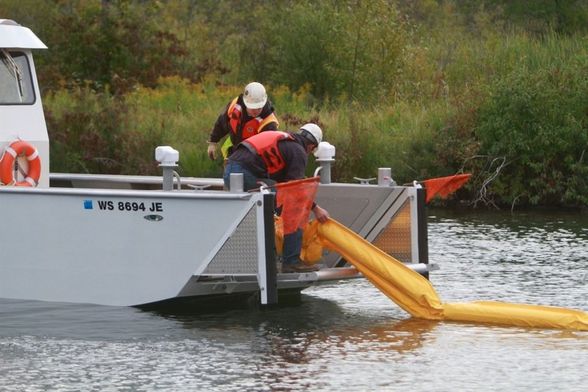Despite being the safest way to transport oil and gas products over long distances, pipelines come with an inherent risk. There are a number of measures that pipeline operators can take to improve safety and minimize the risks associated with the transportation of oil and gas through pipelines. Operators can help to provide environmentally responsible service by using proper construction materials and techniques along with monitoring, maintenance, and inspection practices.
Materials
Pipeline safety first starts with using the right materials when pipes are constructed. Today, steel is the primary material used for hazardous liquid and gas transmission lines, while gas distribution pipelines are constructed of steel or high strength plastic or composites.
Corrosion Protection
Corrosion is a naturally occurring phenomenon which happens when metal reacts with the environment, such as water or soil. Often corrosion results in rust, which can reduce the wall thickness of the pipeline and weaken its strength. A loss of strength could result in a leak or rupture. Pipeline operators employ a number of methods to prevent corrosion on pipelines including exterior coatings, cathodic protection, and corrosion inhibitors.
Special coatings are put on the exterior of the pipeline to stop oxygen and water from reaching the metal and corroding it. Cathodic protection is a system that uses direct electrical current to counteract the normal external corrosion of a metal pipeline. In addition, corrosion inhibitors are substances that can be added to a pipeline to prevent internal corrosion.
Welds
Pipe welding is the process by which two ends of pipe are securely fastened. By law, each welder must pass qualification tests to work on a particular pipeline job, and each weld procedure must be approved for use on that specific job in accordance with federally adopted welding standards. Each welder must complete several welds using the same type of pipe as that to be used in the project. The welds are then evaluated by placing the welded material in a machine and measuring the force required to pull the weld apart.
The quality of welds can also be evaluated with x-ray or ultrasonic technology. These inspection techniques are designed to find gaps in the weld and foreign materials in the weld metal.
Valves
Shut-off valves can be instrumental in reducing the amount of product released in the event of an accident and the subsequent damage caused by a release. Federal law sets basic requirements for installing valves during a pipeline’s construction, but provides operators with discretion in choosing the type and location of shut-off valves.
There are three main types of valves: manual, remote controlled, and automatic.
A manually‐operated valve must be closed by pipeline operating personnel who must be present at the valve site. The time required to close a valve includes the time it takes to determine that closure is needed, the time for the personnel to arrive on site, and the time it takes to actually operate the valve.
Remote controlled valves can be closed by a signal from a remote location such as the control center of a pipeline company. The decision to close a valve is made by a person who interprets pressure and flow data and determines that a pipeline rupture has occurred. The time it takes to close the valve may include time that is spent verifying that a rupture has actually occurred, and then the time it takes for the valve to close.
Automatic valves are designed to close automatically based on pressure and flow data from nearby sensors. No human intervention is required. The valve will close if and when there are changes in pressure or flow rate that cross a pre‐set threshold.
Operating Pressure
Pipelines are designed to a specific strength based on the intended operating pressure. The Maximum Operating Pressure (MOP) is the maximum internal pressure at which a pipeline or pipeline segment may be continuously operated.
All regulated pipelines constructed since 1970 had to be pressure tested before placed into service. In a pressure test, a test medium (gas or liquid) inside the pipeline is pressurized by the use of pumps or compressors to a pressure that is greater than the normal operating pressure of the pipeline. This test pressure is held for a number of hours to ensure there are no leaks in the pipeline. Any indication of leakage requires the identification and repair of the leak.
The flow of oil and gas through pipelines are monitored for problems. Most pipelines use a Supervisory Control and Data Acquisition System (SCADA) which is a computer system that collects information from sensors along the pipeline route. The sensors can measure a variety of conditions including temperature, flow rate, and pressure.
Leak Detection
Pipeline operators are required to have a means to detect leaks on their pipeline systems. They are expected to track product movement along the pipelines in order to ensure that all product going into the pipeline eventually reaches its destination. There are many different leak detection methods. One method is through direct monitoring of pipeline flow and/or pressure for evidence of a leak. This may also involve calculations measuring the intake and outtake volumes looking for product lost. Other ways use complex computational monitoring systems that simultaneously monitor numerous operating conditions.
In addition, pipeline operators are required to conduct regular patrols of pipeline right-of-ways. These patrols, which can be accomplished on foot or aerially, are to check for signs of leaks as well as ensure that no activities, such as excavation, are occurring that could jeopardize the integrity of the pipeline. By law, petroleum pipeline routes must be patrolled at least 26 times a year.
Even with the most sophisticated of leak detection systems, small leaks that fall below the threshold of leak detection systems can be difficult to detect and take the longest time to set off an alarm.
Internal Inspections
Pipeline operators use “smart pigs” that are sent through the buried pipe to evaluate the condition inside and clean the pipe. Smart pigs are advanced inspection tools that use sensors to identify and locate anything out of the ordinary. The pigs carry a small computer to collect, store, and transmit the data for analysis and check for metal loss, cracking, and third-party damage. If an in-line inspection detects a problem, operators will then conduct an integrity dig in which the area around the pipeline is excavated, the pipe coating is removed and the pipeline is visually inspected.
The Integrity Management Program (IMP) is a federal rule that requires operators to identify and assess threats to a pipeline segment. The IMP addresses various threats that could affect the pipeline, including excavator damage, corrosion, operator error, and equipment failure. Rather than focusing on just the pipeline itself, IMP takes a broader view, encompassing the environment as well as pipeline. Pipeline operators are required to know more about the area their pipeline traverses, the nature of the population in the area, and the existence of environmentally sensitive areas near the pipeline. Fundamentally, IMP seeks to understand the potential consequences of failure of a specific pipeline in a particular area. It sets priorities for inspection, operations, and maintenance based on whether people, property, or the environment might be at risk should a pipeline failure occur. Each segment must then be reassessed every 5 years.
Integrity management regulations, intended to reduce both the likelihood and consequences of incidents, have only been in place recently. IMP has been in place since 2000 for hazardous liquid pipelines, 2003 for gas transmission lines, and 2011 for gas distribution pipelines. However, these regulations only apply to pipelines in “high consequence areas” (HCAs) which are defined in law. For natural gas pipelines, HCAs are determined by population density and for hazardous liquid lines, HCAs are determined by population density as well as unusually sensitive areas, such as drinking water sources or commercially navigable waterways. As a result, IMP currently applies to only 44% of hazardous liquid pipelines and 6% of gas transmission lines.
Emergency response planning is a critical component of pipeline operations. It allows pipeline operators and spill responders to establish practices and procedures to manage emergency situations and mitigate the environmental impacts of a spill.
By law, operators of oil pipelines are required to develop response plans that outline their planning, training, and response to an oil spill. Planning elements include a determination of a worst-case discharge, pipeline operator contact information, an inventory of oil spill equipment and supplies, and a spill response training program and exercise schedule.
In addition to individual response plans prepared by the pipeline companies, emergency responders also conduct planning measures. The National Response System, created by federal law, provides guidance and procedures for preparing for and responding to discharges of oil and hazardous substances. This is accomplished through contingency plans that describe information and processes for containing and cleaning up an oil spill in a defined geographic area. There are a variety of contingency plans ranging from nationwide plans to subarea plans.
For the Great Lakes, and Northern Michigan in particular, the following plans provide guidance in the event of an emergency: the U.S. National Oil and Hazardous Materials Contingency Plan (NCP), the U.S. Coast Guard District 9 Area Contingency Plan (ACP), the Federal Region 5 Regional Contingency Plan, and the Northern Michigan Sub-Area Contingency Plan.
In addition to contingency plans, personnel must be trained to react quickly and efficiently in the event of a spill. This is accomplished through drills and exercises. These events vary in size and scale, and can be planned in advance or be unannounced. Some events are small and occur regularly and some are large and intensive. There are table-top exercises and full-scale drills in which a large emergency response team is activated, and more than 200 people, including governmental agencies and community organizations, rehearse the response to a large spill.

